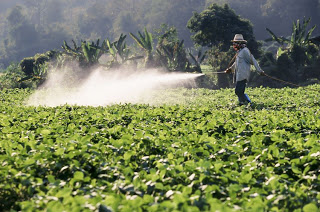What do Pesticides, Herbicides and Antibiotics have in Common?
By Case Adams
There are three natural catastrophes occurring within nature in slow motion at the moment and they are our fault. All three catastrophes stem from the same kind of mistake made by human science and corporate greed. What are they and what are we doing wrong?
The slow-motion catastrophes are:
- antibiotic-resistant pathogenic bacteria – often termed ‘superbugs’
- pesticide-resistant pests – also called ‘superbugs’
- herbicide-resistant weeds – now termed ‘superweeds’
What do these three have in common?
All three are the result of the application of synthetic toxicity within nature in an attempt to work outside nature’s normal processes. The application of toxins meant to inhibit certain organisms produces resistance, because living organisms by nature seek to survive, and will adapt to toxicity in order to continue their survival.
Widget not in any sidebars
This ability to adapt has been studied for many years by scientists and is well known among biology and evolution science. It is one of the foundations of biology taught at the most fundamental levels of instruction for any beginning scientist.
Yet the scientific community has failed to understand how this most fundamental part of nature will interact with the toxicity that we have introduced over the past century. Did the scientists who developed these synthetic toxins really believe those toxins would provide a permanent solution?
We obviously ignored this most fundamental understanding that living organisms will adapt to toxins. We forgot that organisms will develop defense mechanisms that will override deterrent toxins – producing a stronger organism in the process.
Let’s examine this aspect in all three cases:
Antibiotics Produce Plasmid changes
Antibiotics – or antibacterials – exist in nature, but modern synthetic (static) antibiotics began their development in the nineteenth century among early microbiologists who discovered ways to combat disease by inhibiting bacteria with either antiseptic chemicals or infused antibiotics derived from other microorganisms. Their discoveries led to major advancements in knowledge regarding how to kill bacteria. For example, the Italian Vincenzo Tiberio discovered that the Penicillium mold would remove bacteria from well water.
These of course were noble causes and their discoveries have resulted in millions of lives saved from various infections. But is there a long-term cost of waging war against bacteria outside of nature’s means – using static toxins?
Later scientists found that bacteria will produce what is called a plasmid – a term suggested by Joshua Lederberg in the early 1950s. A plasmid is a collection of genetic material passed on during procreation and even peer-exchange that teaches a bacteria how to resist that particular antibacterial. Even a single bacterium may develop a plasmid change and then pass that plasmid change on to others – both within and outside their species. This passing on of plasmid changes allows bacteria to teach others how to resist that particular toxic agent.
We might compare this to warfare among humans. Once we began fighting with swords, the opponents developed shields. After humanity created missiles, the opposition developed anti-missile weapons. After we created nuclear bombs we created nuclear defense mechanisms and bomb shelters.
Bacteria are no different. They are also living organisms who want to survive, so they can learn how to evade an antibacterial agent.
 The only problem is that as this escalation continues, those who position themselves as enemies will now be dealing with a stronger organism. This is the case of antibiotic-resistant species of bacteria such as MRSA (Methicillin-resistant Staphylococcus aureus) and numerous species that cause HAIs – hospital acquired infections.
The only problem is that as this escalation continues, those who position themselves as enemies will now be dealing with a stronger organism. This is the case of antibiotic-resistant species of bacteria such as MRSA (Methicillin-resistant Staphylococcus aureus) and numerous species that cause HAIs – hospital acquired infections.
The same exact premise is taking place among weeds. Since 2000 the increasing application of glyphosate has produced a growing legion of superweed horseweeds and other types of herbicide-resistant weeds.
The Growth of Superweeds from Herbicides and GMOs
In a recent paper by Food & Water Watch, the dramatic rise in the application of herbicides in the U.S. over the last 10 years has led to a growing legion of superweeds. In the 2013 report, called Superweeds: How Biotech Crops Bolster the Pesticide Industry, found that the dramatic rise in the application of herbicides such as glyphosate between 2001 and 2010 has led to an explosion of growth of herbicide-resistant weeds.
From 2001 to 2010, toxic herbicide application grew by 81 million pounds – 26 percent. But the application of glyphosate to the three biggest genetically engineered crops skyrocketed from 15 million pounds in 1996 to 150 million pounds in 2012 – this is a ten-fold rise in the application of glyphosate.
Prior to the domination of glyphosate and genetically modified “RoundUp Ready” seeds, atrazine was the leading herbicide used. Both atrazine and glyphosate have been linked to endocrine disruption, and atrazine has been the subject of study by university researchers for its causing mutations among frogs and fish.
As a result of the growth of GMO herbicide-friendly seeds, glyphosate-resistant weeds have been reported in 21 states – up from zero states reporting prior to 2000. The resistant weeds began in the South and spread to other states. By 2012, 92% of Georgia farmers reported glyphosate-resistant weeds, and states throughout the midwest were being swamped by them.
These resistant weeds include ragweed, amaranth, horseweed, bluegrass and waterhemp. Ragweed of course is also a common hayfever allergen – and hayfever is also on the rise in the U.S.
A similar problem is appearing as a result of the growing application of pesticides onto genetically modified crops. Research from the University of Minnesota found that the corn rootworm is developing a resistance to GMO corn and the pesticides applied to it such as Bt and 2,4-D. A recent interview with agronomist Todd Claussen from the Brownfield publication indicates that Iowa farmers are dealing with 40 to 50 times the rootworm infection considered normal – and he attributes this to resistance to soil insecticides.
What do these mistakes have in common? All three were produced by scientists forgetting the fundamental biology lesson that every living organism strives to survive and thus will adapt and develop resistance to toxins that attempt to interrupt that survival.
And the consequences of these adaptations mirror the attempts to inhibit them. In the case of the application of static antibiotics, we are running out of them as bacteria become resistant. In the case of the application of toxic chemicals onto pests and weeds, those pests and weeds are becoming resistant to those toxic chemicals.
There are two backlashes to these developments. The first is that we have to increase the application of these toxins in order to get similar results. This means that we become exposed to more toxins – as illustrated in all three instances: The rise in antibiotic use, pesticide use and herbicide use.
The second backlash is that as these living organisms adapt they become stronger. This means it becomes more difficult to inhibit them by any means. (Rendering the adage: “I’ve created a monster!”)
Both of these consequences ruins it for other living organisms – including humans – which become threatened by a combination of those stronger living organisms and the increased exposure to toxins.
Is there a Solution to our Toxic Science?
The solution is to work within nature’s means. This means finding those strategies that naturally inhibit those pathogenic organisms. In the case of weeds and pests, crop rotation and the feeding of organic biomass into the soil. This will enrich the soil and help strengthen the plants’ own immunity against pests – can help resist pests, along with the utilization of natural predators that already exist in nature. Naturally enriching the soil will also give rise to natural stewards of plants such as earthworms – which help combat other pests and help nourish plants with their own waste production as they convert natural fertilizers.
In addition to these, there are numerous natural substances that repel pests, including castor oil, extracts of mint, basil, garlic and other natural means that utilize evolution to repel pests.
In the case of antibiotic-resistant bacteria, the solution lies in employing those natural agents – inclusive of many different antibacterial herbs – that inhibit the growth of bacteria. Another important tool are those probiotic bacteria that are already living within our bodies and can produce their own antibiotics that fight off pathogenic bacteria – as well as fungi and viruses.
The other means to protect ourselves naturally comes in the form of increasing our own natural immunity. The comes by way of a better diet, plenty of exercise and a healthy lifestyle in general.
The bottom line is that scientists and humanity in general must become better skilled in observation. This means observing nature and its consequences.
Widget not in any sidebars
What modern science – increasingly driven by corporate profit objectives – has overlooked is that by working within nature we employ those very tools that have been developed by the same evolution that has developed the creatures that threaten our survival. Now that we’ve turned away from nature, we are left to our own toxic devices – unleashing unnatural mutations and toxicity that will destroy our own ability to survive.
Learn more about working with nature.
REFERENCES:
Food and Water Watch. Superweeds: How Biotech Crops Bolster the Pesticide Industry. July 2013. http://documents.foodandwaterwatch.org/doc/Superweeds.pdf
Adams C. GMO Corn Worsens Drought Damage with Rootworm Outbreak. http://www.greenmedinfo.com/blog/gmo-corn-worsens-drought-damage-rootworm-outbreak
Realnatural. Herbicide Turn Male Frogs into Females. http://www.realnatural.org/herbicide-turns-male-frogs-to-females/
Adams C. PROBIOTICS: Protection Against Infection. Logical Books, 2011.
Case Adams is a California Naturopath and holds a Ph.D. in Natural Health Sciences. His focus is upon science-based natural health solutions. He is the author of 25 books on natural health and numerous print and internet articles. A listing and description of many of his books can be found on Realnatural.org. A new video series on low back pain can be found on Healthy-back.net. Case appreciates feedback and questions at [email protected].




